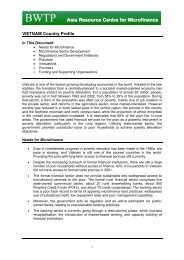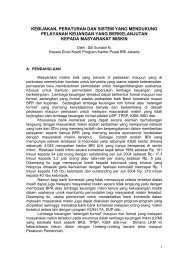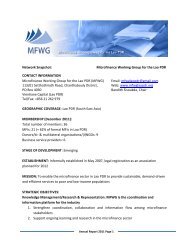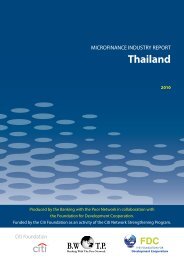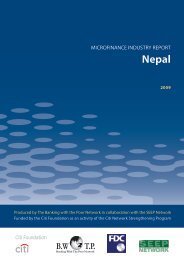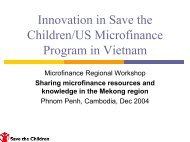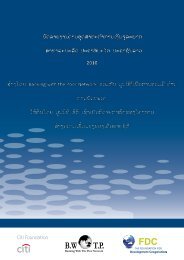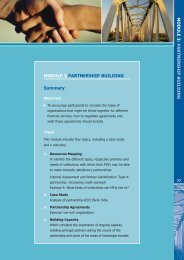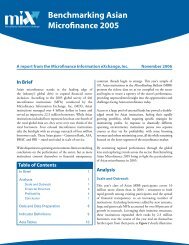microfinance industry report - Vietnam - Banking with the Poor Network
microfinance industry report - Vietnam - Banking with the Poor Network
microfinance industry report - Vietnam - Banking with the Poor Network
You also want an ePaper? Increase the reach of your titles
YUMPU automatically turns print PDFs into web optimized ePapers that Google loves.
4. Microfinance Sector Development<br />
4.1 History<br />
Microfinance in Viet Nam has its roots in government<br />
social protection measures for <strong>the</strong> poor. Because<br />
<strong>the</strong> vast majority of <strong>the</strong> poor population lives in<br />
rural areas, <strong>microfinance</strong> has traditionally been<br />
interpreted as <strong>the</strong> market for financial services for<br />
rural households. Micro-credit in particular has<br />
been interpreted as <strong>the</strong> provision of subsidized<br />
credit facilities for <strong>the</strong> poor, and quantitative<br />
‘coverage targets’ have been promoted in response<br />
to a perceived unmet demand for credit among <strong>the</strong><br />
rural poor. This has resulted in supply-driven efforts,<br />
led by <strong>the</strong> government <strong>with</strong> <strong>the</strong> participation of<br />
many donors, INGOs, and NGO programs which are<br />
manifested by embedded revolving credit funds in<br />
o<strong>the</strong>rwise well-focused community development<br />
and social mobilization interventions. Comparatively<br />
less attention has been paid to <strong>the</strong> quality of <strong>the</strong> debt<br />
finance provided, <strong>the</strong> sustainability of <strong>the</strong> institutions<br />
providing <strong>the</strong> service, and <strong>the</strong> repayment capacity of<br />
borrowers. Increasingly, however, more market-led<br />
arrangements are developing.<br />
The People’s Credit Funds were established in 1993<br />
to address <strong>the</strong> huge demand for productive credit in<br />
rural areas created by <strong>the</strong> agricultural reforms in <strong>the</strong><br />
early 1990s after <strong>the</strong> communist credit cooperatives<br />
failed in <strong>the</strong> late 1980s.<br />
The Hunger Eradication and Poverty Reduction Plan<br />
(HEPR) launched by <strong>the</strong> <strong>Vietnam</strong>ese Government in<br />
1997 focused on improving poor people’s access to<br />
financial services, especially in rural regions. HEPR<br />
was formally established in 1998 as a nationwide<br />
framework for integrating poverty reduction efforts<br />
targeted at poor households and poor communes.<br />
Government-owned banks (Viet Nam Bank for<br />
Agriculture and Rural Development (VBARD) and<br />
Viet Nam Bank for Social Policies, VBSP) became <strong>the</strong><br />
dominant providers of financial services to <strong>the</strong> lowincome<br />
population, and used <strong>the</strong> extensive network<br />
of <strong>the</strong> political mass organizations to mobilize,<br />
appraise, and monitor clients.<br />
Viet Nam’s Party-led government has enabled <strong>the</strong><br />
mass organizations to be important stakeholders<br />
in <strong>the</strong> <strong>microfinance</strong> sector both at <strong>the</strong> policy and<br />
<strong>the</strong> operational level. These MOs, and <strong>the</strong> Viet Nam<br />
Women’s Union in particular, have been successful in<br />
attracting project funding for <strong>microfinance</strong>, as it has<br />
been one of <strong>the</strong> only legal partners for international<br />
non-governmental organizations and programs<br />
wishing to provide <strong>microfinance</strong> in <strong>the</strong> country. Most<br />
of <strong>the</strong> semi-formal <strong>microfinance</strong> programs established<br />
since <strong>the</strong> 1990s are thus legally authorized, owned,<br />
or implemented by <strong>the</strong> VWU at central or local levels.<br />
Some social funds operated by mass organizations<br />
have specialized in <strong>microfinance</strong>, including <strong>the</strong> Tau<br />
Yeu May Fund (TYM) established by <strong>the</strong> VWU in 1992<br />
and <strong>the</strong> Capital Aid Fund for Employment of <strong>the</strong><br />
<strong>Poor</strong> (CEP), established by <strong>the</strong> Labor Confederation<br />
in Ho Chi Minh City in <strong>the</strong> same year. Today, some<br />
28 organizations offer <strong>microfinance</strong> services in 36<br />
provinces (57% of total provinces) but <strong>the</strong>y have,<br />
<strong>with</strong> a very few exceptions, been unable to attain<br />
significant scale and sustainability.<br />
4.2. The Retail Sector: Financial<br />
Service Providers<br />
The <strong>Vietnam</strong>ese <strong>microfinance</strong> market is characterized<br />
by <strong>the</strong> dominance in scale and depth by three formal<br />
providers, <strong>the</strong> state-owned VBARD, <strong>the</strong> policy lender<br />
VBSP and <strong>the</strong> 984 People’s Credit Funds. These main<br />
providers all pursue <strong>the</strong> market for small, particularly<br />
rural loans and savings accounts, but <strong>with</strong> very<br />
different approaches. The Viet Nam Postal Savings<br />
Company, established in 1999 has <strong>the</strong> potential to<br />
become an important deposit mobilizer in Viet Nam<br />
<strong>with</strong> convenient outreach and competitive interest<br />
rates.<br />
>> Viet Nam Bank for Agriculture and Rural<br />
Development, VBARD or AgriBank, is <strong>the</strong> largest<br />
bank in <strong>the</strong> country and by far <strong>the</strong> largest provider<br />
of <strong>the</strong> full range of financial services in rural Viet<br />
Nam. The darling of <strong>the</strong> donor community, VBARD<br />
has implemented 111 projects at a value of $4<br />
billion, as at end 2007, <strong>with</strong> large and subsidized<br />
credit lines received from ADB, <strong>the</strong> World Bank, and<br />
Agence Français de Developpement in particular.<br />
VBARD specializes in lending to rural households<br />
and SMEs involved in agriculture or off-farm<br />
enterprises, but <strong>the</strong> bank has recently expanded<br />
<strong>Banking</strong> With The <strong>Poor</strong> <strong>Network</strong> 21<br />
<strong>Vietnam</strong>e_Report_FOR_PRINT.indd 21<br />
27/05/2009 7:46:02 PM



